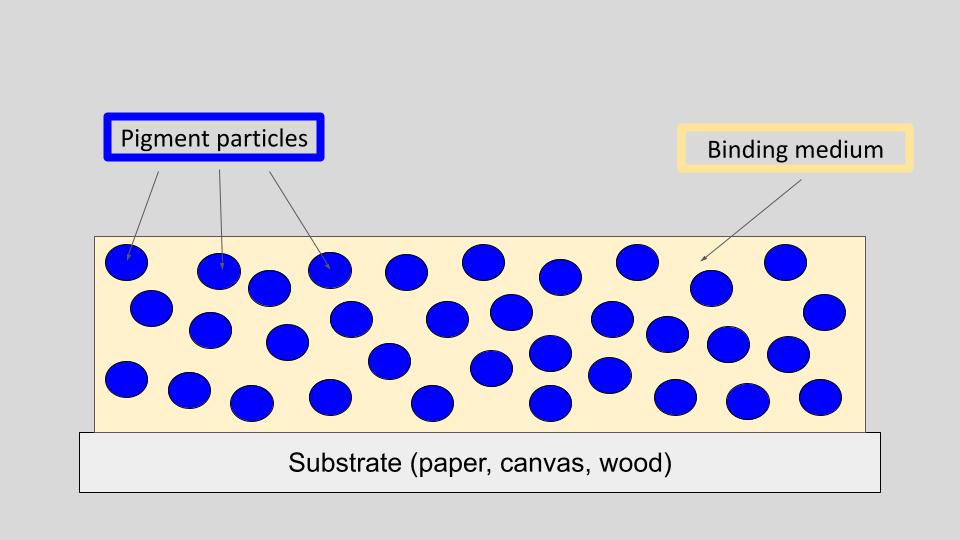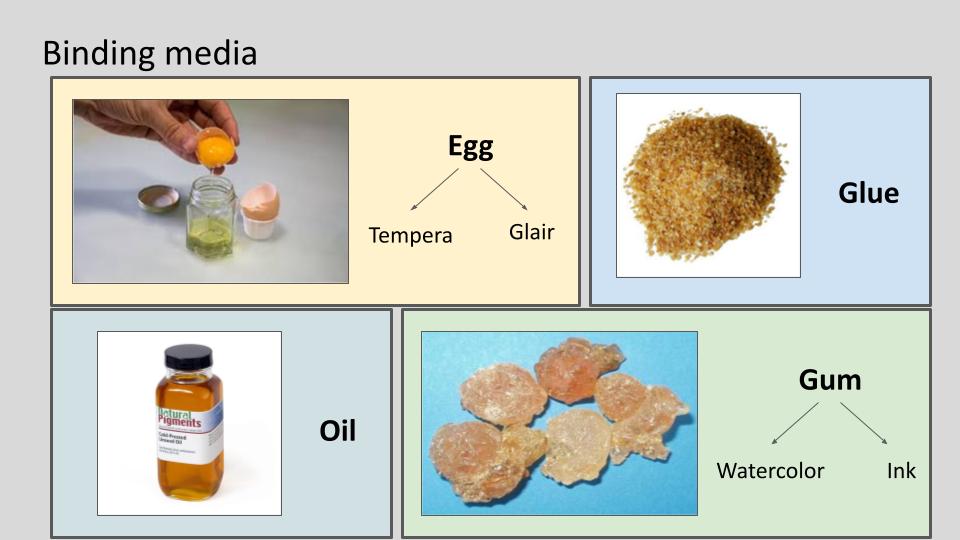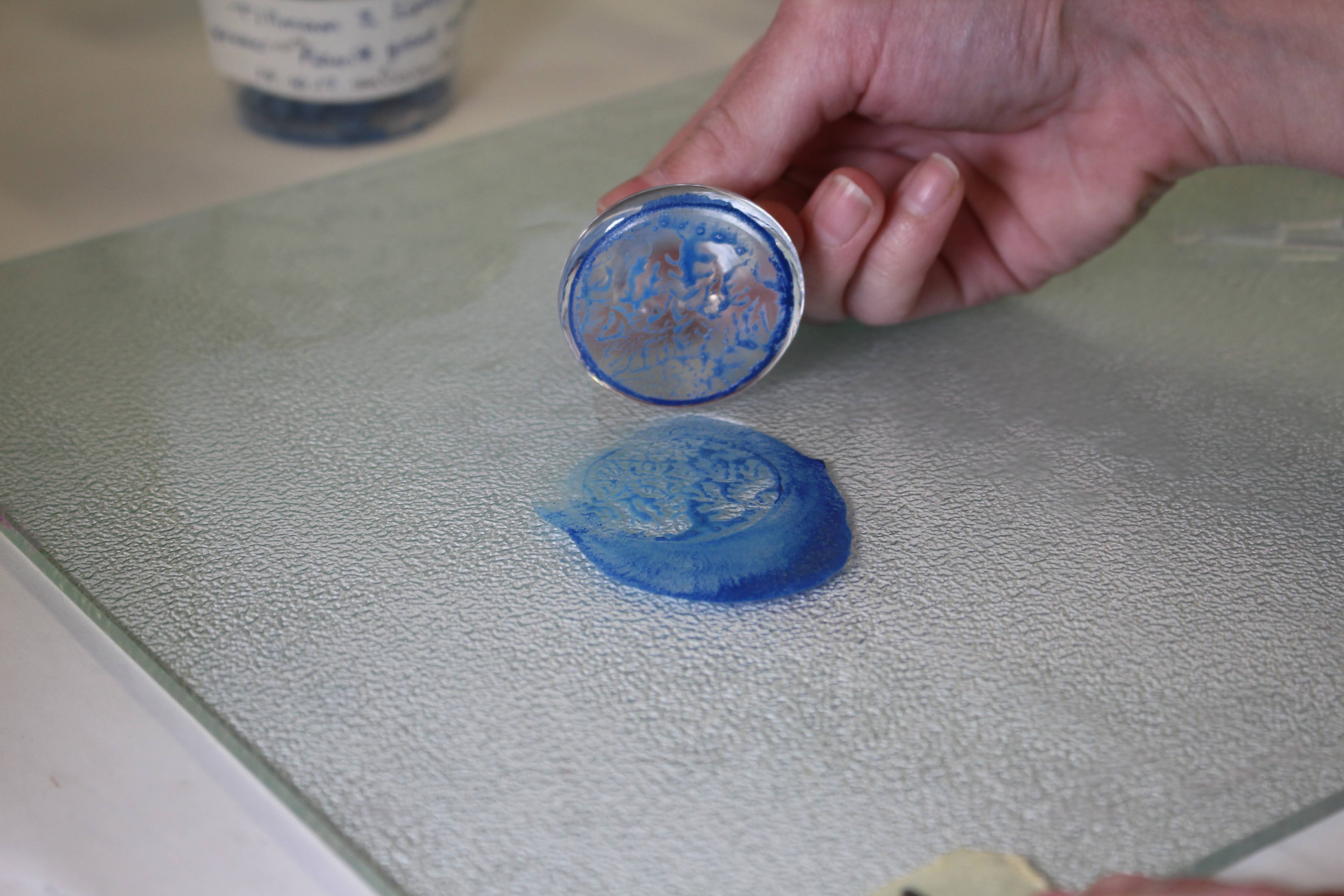Making and Testing Paints Made by Hand from Pigments

The Making and Knowing Project has used paint and test card making as a core skill-building exercise for its students. Paint making has often been a follow-up activity to lake pigment making or verdigris growing, but paint making can also be undertaken using commercially produced pigments.
Learning Objectives
The activity of making paint and testing out those paints on a sample card has several potential learning outcomes, which can include:
- learn how paint is made
- exprience how different binders behave during the mulling process
- experience how the mulling of pigments, paint consistency, and specific combinations of pigment and binder affect the application and appearance of paint
- understand material considerations that affect the appearance of artworks across history
What is Paint?
Paint = pigment + binder
For more on paint making, refer to Presentation: Introduction to Pigments & Paints.

Pigments
Pigments are colored, insoluble particles that, when combined with a binding medium, create paint that can then be applied to a substrate. Historically, most pigments were sourced from the natural environment, including from plants, insects, stones, and dirt. Since the nineteenth century, the synthesis of pigments in industrial settings has become very common, ensuring consistent quality and new formulations.

Binders
Binders are materials that bring cohesion and unity to particulate matter. In the case of paint, binders are what turn powdered pigment into a viscous material that can be applied to a substrate such that it adheres. Binders for paint are divided into two main categories:
- water-based (aqueous): egg yolk, egg white, various gums
- oil-based: linseed oil, walnut oil, waxes, resins


Mulling
Mulling is a mechanical process used to thoroughly combine a pigment with a binder. It involves grinding the pigment and binder together on a hard surface, often a glass plate or marble slab, using a muller–a pestle-like, flat-bottomed tool, often made of glass. There are various techniques for manipulating the muller on the plate that can facilitate the process of paint-making, such as moving the muller in a figure-8 pattern or in a series of small circles moving around in a larger circle. In all cases, pressure must be applied to the muller in order to help grind the pigment particles into the binder. Most paints require that the pigments be mulled so that no further particles are visible or, put differently, so that the resultant paint is smooth.


Substrates or Supports
Paint is applied to a variety of supports, including canvas, panel, plaster, paper, and metal, just to name a few. Some paints adhere better to particular supports than to others. See Preparing Panels, Canvases, and Other Supports for Painting, Gilding, and More.
For an overview of stretching and gessoing canvas for painting, refer to Presentation: Preparing the Canvas Support and Presentation: Preparing Gessoed Test Panels.

Teaching Paint Making
Making Paint in the Classroom: Presentations
- Presentation: Introduction to Pigments & Paints
- Presentation: Preparing to Paint and Painting in Distemper, Tempera, and Oil
- Presentation: Flower Painting in Oil According to Willem Beurs
Making Paint in the Classroom: Activity Sheets
- Classroom activity sheet for paint making [pdf]
- Classroom activity sheet for preparing gessoed test panels to receive paint samples [DOCX] [PDF]
- Classroom activity sheet for stretching canvas to paint on [PDF]
- A sample card painted from lake pigments in various binding media [PNG]
Making Paint in the Classroom: Reflection Assignment
Painting in Ms. Fr. 640
There are dozens of entries in Ms. Fr. 640 that address elements of paint making and painting, including pigment behavior, mulling (grinding), binders, handling, and the practical uses of particular materials for various kinds of subject matter (e.g., flesh tones). In fact, “painting” is one of the categories that M&K has used to classify the various entries in the manuscript, and entries on painting account for roughly 15% of the manuscript’s contents. These entries are best accessed by searching the manuscript for “painter” and “painting.”
There are also several essays in Secrets of Craft and Nature in Renaissance France that explore paint making and painting in detail, including:
- Jo Kirby and Marika Spring, “Ms. Fr. 640 in the World of Pigments in Sixteenth-Century Europe.”
- Cleo Nisse, “Shadows Beneath the Skin: How to Paint Faces in Distemper.”
- Sumeyye Yar, “Painting in Oil on Taffeta II.”